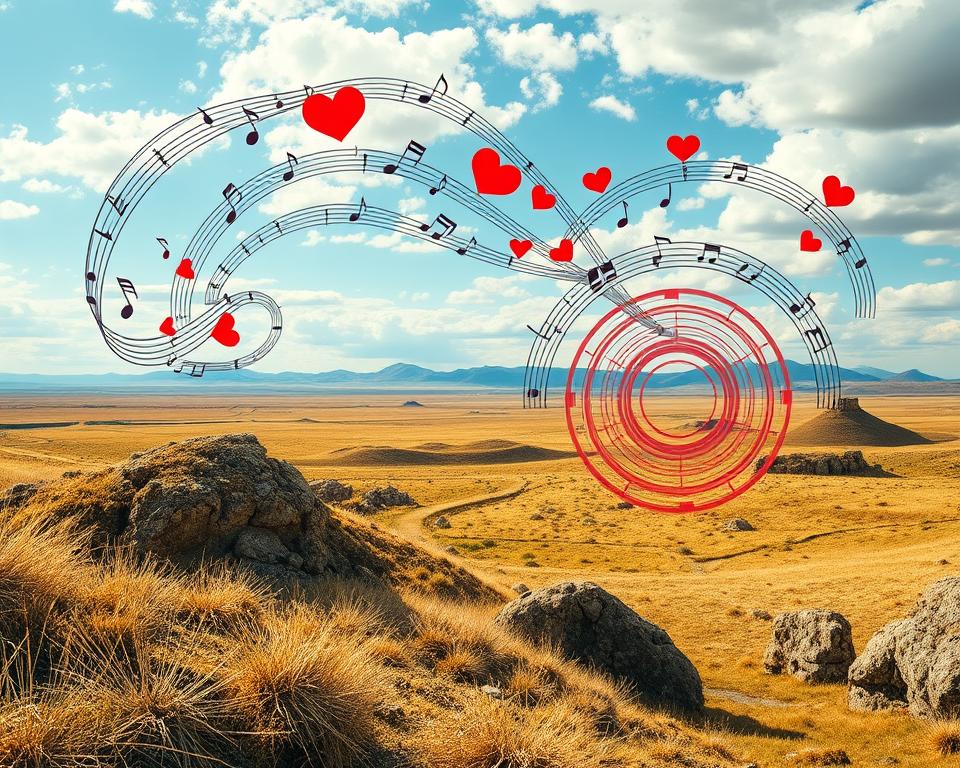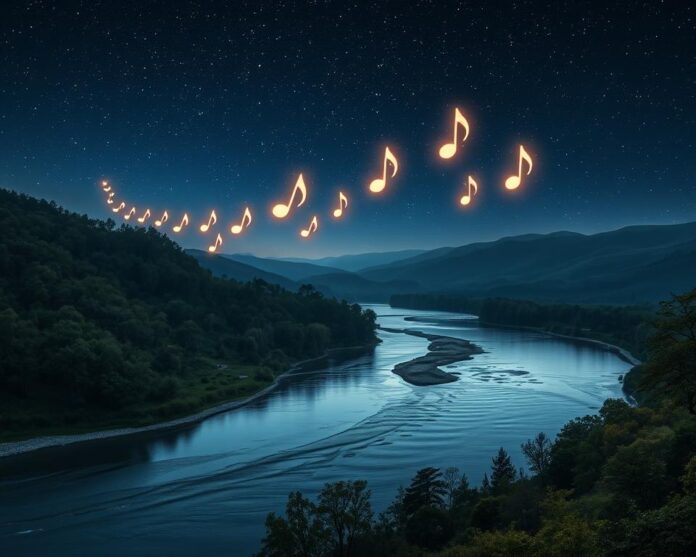A surprising statistic shows that 49 answers were shared about ballads. 13 users marked some as their favorites. This highlights the big impact ballads have on people’s lives.
Ballads have been a key way to tell stories for centuries. Songs like “Unforgettable” by Nat King Cole and “I Will Always Love You” by Whitney Houston are examples. They are part of the ballad definition of love songs.
These songs touch our emotions and connect us, making ballads a timeless favorite.
In a thread, 24 specific song titles were recommended. This shows how important ballads are in keeping history and culture alive. Many artists, like Stan Rogers, Buffy St. Marie, and Bruce Springsteen, have added to this rich storytelling tradition.
What is a Ballad?
A ballad is a type of verse that tells a story. It often has a folkloric or legendary theme. The word “ballad” comes from the Old French “ballade,” meaning “dancing song.” Ballads have a long history, starting in medieval Europe and the Middle East. They have changed over time, now including traditional and modern forms.
Traditional ballads focus on storytelling and poetic language. They follow a specific rhyme scheme and meter. Many have a refrain, like a song chorus. Ballad poetry is key, using lyrical and expressive language.
Definition and Characteristics
Ballads use quatrains with a specific rhyme scheme. They aim for a bold, sensational effect. This is achieved through rhetorical devices like incremental repetition. The tradition of ballads is dynamic, with ongoing changes.
Historical Origins
The first ballads were recorded in the 14th century. They come from medieval Europe and the Middle East. Today, ballads include traditional and modern styles. Ballad examples can be found in many cultures, like British, American, and Spanish.
Types of Ballads
There are different types of ballads. Traditional ones have a narrative and poetic style. Folk ballads often deal with love and adventure. Contemporary ballads, like ballad songs, mix modern themes with traditional forms.
The Evolution of Ballads Through Time
Ballads have changed a lot over the years. They have moved from traditional forms to modern ones like folk and rock ballads. This shows how the ballad genre has grown and changed with society.
The ballad form has also been shaped by new technologies. The printing press helped spread broadside ballads far and wide. These ballads talked about current events and were shared widely. Places like the Appalachian Mountains and New England helped shape the ballad structure and ballad form.
Historical examples like the Robin Hood Cycle show ballads’ lasting charm. The ballad genre keeps evolving, adding new themes and styles. Yet, it still holds onto its traditional ballad structure and ballad form. Ballads are a key part of our culture, giving us a glimpse into human stories and experiences.
Transitions in Style
The move from old to new ballad forms has brought more variety and creativity. This has made the ballad genre appealing to more people. It has also inspired many musicians and writers to explore new sounds and stories.
The Role of Ballads in American Culture
Ballads have been a big part of American culture. They tell stories of love, loss, and everyday life. Songs like “Home on the Range” and “The Battle Hymn of the Republic” are key to our culture.
These songs have shaped folk music in America. Passed down through generations, they share stories of history and myths. Over time, they’ve changed to reflect American values and experiences.

Ballads also influence today’s music. Many artists use the ballad style to connect with the past. This way, they can share their stories in new and exciting ways. Ballads keep American music alive, linking us to our heritage.
Influence on Folk Music
Ballads have shaped folk music in America. They tell stories of history, legends, and myths. These songs have helped form our cultural identity.
Impact on Contemporary Music
Ballads also impact today’s music. Artists use the ballad style to connect with the past. This lets them share their stories in fresh and creative ways.
Famous Ballad Writers and Artists
Many talented writers and artists have shaped the ballad genre over time. Legendary songwriters like Bob Dylan and Joni Mitchell have made big impacts. Today, artists like Adele and Sam Smith keep the genre alive and evolving.
The ballad form has been loved for over 600 years, starting in medieval Europe. Famous poems like “The Rime of the Ancient Mariner” by Samuel Taylor Coleridge are key in English literature. Cowboy and Irish Ballads have also shaped the genre, adding to its rich history.
Modern ballads cover themes like love, sentiment, and social commentary. Poets like Emily Dickinson and John Keats have used the ballad metre in their work. The word “ballad” comes from the Latin ‘balar’, meaning ‘to dance’, showing the genre’s roots in folk music.
Legendary Songwriters
Legendary songwriters have greatly influenced the ballad genre. Bob Dylan’s use of the ballad metre has inspired many. Joni Mitchell’s ballads, like “Both Sides Now”, are classics, showing her skill in the traditional ballad form.
Contemporary Ballad Artists
Today’s ballad artists bring new themes and styles to the genre. Adele’s powerful ballads, like “Someone Like You”, have become anthems. Sam Smith’s soulful voice adds emotional depth, expanding the ballad definition.
How to Write Your Own Ballad
Writing a ballad is a fun way to express your feelings and tell a story. It’s all about ballad poetry and ballad songs. First, learn the basic structure and rhyme schemes. Traditional ballads have four-line stanzas with a specific rhyme and meter.
Looking at famous ballads like “Danny Boy” can inspire you. These ballads use imagery and rhyme to tell a story. When writing, focus on the emotional story, using ballad poetry to touch the reader’s heart.
A great ballad captures emotion well. Use vivid imagery and descriptive language to make the story come alive. Try different rhyme schemes and meters for your ballad songs. With practice, you can create a ballad that touches others.
Basic Structure and Rhyme Schemes
Understanding the structure and rhyme schemes is key. Ballads often follow the ABAB or ABCB rhyme scheme. This creates a rhythm that makes the ballad enjoyable to read.
Tips for Capturing Emotion
To capture emotion, use sensory details and descriptive language. Create a vivid picture in the reader’s mind. Try using metaphors and similes to add depth to your ballad poetry.
The Emotional Power of Ballads
At the heart of the ballad lies a captivating ability to evoke deep emotions. These timeless musical narratives resonate with listeners’ personal experiences. They transport us through a tapestry of human sentiment, from love’s euphoric heights to sorrow’s depths.
The themes in traditional ballads often reflect the universal human condition. They delve into the complexities of our experiences. Whether it’s unrequited love or enduring hardship, these ballad definitions mirror our emotions, offering a cathartic outlet.
The connection between the listener and the ballad is unique. Ballads tap into shared human experiences, forging a deep bond. They allow individuals to find solace, inspiration, and a sense of community in the shared language of emotion.










